Operations Over the Reich
Once the Luftwaffe staff had evaluated the experience of several test commandos, they decided to introduce the Me 262 and equip whole Geschwader with the aircraft. JG 7 was selected to receive the Me 262 A-la first. Eleven machines had arrived by the end of November 1944 following Kommando Nowotny being disbanded, and most completed aircraft were delivered there. Using previously – gained expertise it was relatively easy to get a Staffel of III./JG 7 operational, but the supply of new aircraft fell short of the numbers wanted by the Geschwader – by 10 January 1945 it had only 19 Me 262s.
During that period the first jets had been delivered to 1. and 3. Staffel of I./JG 7 at Kaltenkirchen. The commander of the incomplete Gruppe was Knight’s Cross holder Oberst Johannes Steinhoff. On 14 January the former
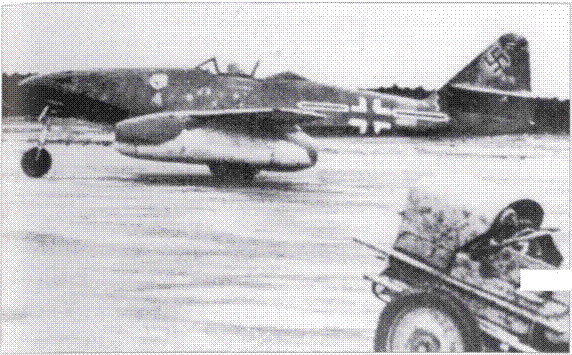
commander of I./JG 7, Major Theodor Weissenberger, took over from Steinhoff. In January 1945,1. Gruppe took charge of 15 and III. Gruppe of 11 Me 262s, from which it was calculated that JG 7 would not be at hill strength for at least two to three months.
On 8 February OKL redesignated IV./JG 54 as II./JG 7, and shortly afterwards I. Gruppe had 12 new jets while III. Gruppe was close to full strength. A few days later II./JG 7 began re-equipping with the new fighter. Whilst this re-formation of the Gruppen was under way, the possibility of combat had been rather thrust into the background. The immediate necessity was for pilots to undertake more training flights to gain experience with jet aircraft. Even so, some of the more experienced fliers obtained victories against Allied machines, amongst them Hauptmann Georg ‘Schorsch’ Eder, Oberleutnant Gunther Wegmann and Leutnant Rudolf‘Rudi’ Rademacher.
In the first major sortie on 21 February, 15 Me 262s of the Stabsstaffel and III. Gruppe engaged P-51 Mustangs of479th Fighter Group over Potsdam, but none of the various piston-aircraft aces obtained a shooting opportunity. Only gradually did the successes come. Almost daily in addition to the usual technical problems there were serious faults and pilot errors which caused fatalities amongst JG 7 airmen.
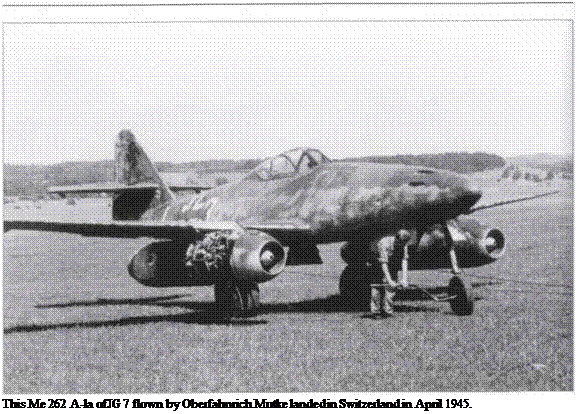
In February 1945 JG 7 received a total of 42 Me 262s to replace losses and increase its complement. These were distributed 25 to I./JG 7,10 to II./JG 7 and 7 to III./JG 7. The Geschwader was thus still in the expansion phase at the beginning of March. Although the number of daily flights rose, Allied aircrews were not confronted by large jet formations. However, the new machine was soon carving its reputation amongst B-17 and В-24 bomber crews over Germany. The four 30 mm MK 108 cannon would bring down a heavy bomber with only a few hits, while a single hit from an R4M rocket would do the same. Rockets were carried below the wings in wooden racks. The first Staffel to be equipped with the R4M was 11./JG 7.
The first clash occurred on 18 March. The target was bombers heading for central Germany. In tussles with the escort fighters, the Geschwader lost several of its best pilots including Oak Leaves holder Oberleutnant Hans-Peter Waldmann and Oberleutnant Gunter Wegmann, the latter parachuting to safety although seriously wounded.
In the heavy air raids over Swabia and Bavaria on 22 March 1945,28 Me 262s were lost, a setback in the current war situation which could not be made good
quickly. In subsequent attacks by ‘fast fighters’, as they were termed in War Diary entries, against Eighth Air Force units, five jets were lost on 26 March. Four days later in an engagement over northern Germany, 36 Me 262 fighters from
III. /JG 7, some armed with the R4M rocket, scored successes. Instilled with confidence, on 31 March pilots of I. and III./JG 7 claimed to have destroyed 21 heavy bombers including 12 RAF Lancasters taking part in a daylight raid. In an action against all three divisions of Eighth Air Force on 1 April 1945, 32 Me 262s were involved. For the loss of only four of their own the German aircraft shot down 15 enemy aircraft. Successes were also reported by Me 262 pilots against a 300-strong bomber force heading by day for Hamburg.
Between 1 and 4 April, I./JG 7 was transferred from Kaltenkirchen to central Germany to give better cover over the remaining Reich territory. Although other Gruppen in the process of formation had litde flying training, their pilots hoped for the chance to fly operations soon. During April 1945 the expansion of
IV. 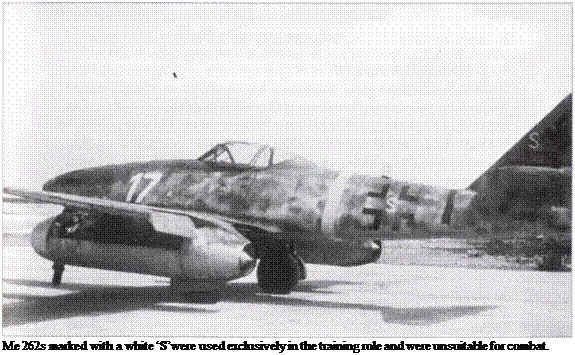
/JG 7 had started, but proceeded only slowly and trickled to a halt by the end of the month. Nevertheless the victories obtained by operational pilots did increase. Between 2 and 6 April alone, JG 7 shot down at least 60 enemy aircraft, although at a high price: 146 pilots were either killed, wounded or landed by parachute sustaining injury. These men came principally from I. and III./JG 7.
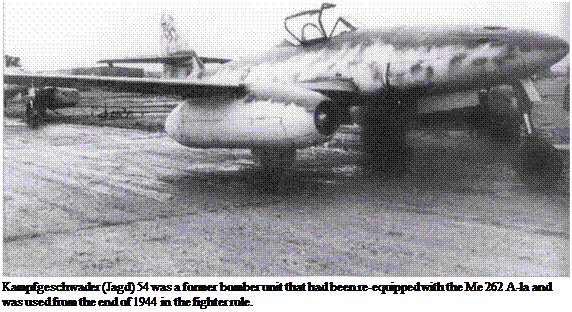
Major Heinrich Ehrler of the Stabsstaffel rammed a B-17 after having gunned down two or three others. He claimed 201 victories in all and received the Oak Leaves, but fell in action over the Reich on 6 April 1945.
On 7 April 1945 there occurred the despairing Sonderkommando Elbe operation in the Magdeburg area when American bomber formations were attacked by 183 Rammjciger over the Steinhuder Meer; 77 pilots were lost in the ramming action, and only 50 aircraft returned. JG 7 flew escort and support,
I. /JG 7 shooting down several P-5 Is and B-24s over northern Germany. In all 28 victories were claimed by Me 262 pilots. On 10 April 25 jets scored five victories over the shrinking Reich. Near Magdeburg Oberleutnant Walter Schuck of III./JG 7 shot down three B-17s and rammed a fourth, landing safely by parachute. In this action the Geschwader lost seven pilots dead and two seriously wounded. Other aircraft were disabled but outflew their pursuers and landed safely. Over Saxony on 14 April Oberleutnant Fritz Stehle and Leutnant Rademacher had successes, the latter claiming three B-17s. Hits sustained during combat with the American bomber fleets decreased day by day the number of Me 262s operational. Since there were few replacements, in mid-April the
Geschwader was converted into a mixed fighting unit. On 19 April over Prague and environs it shot down at least six B-17s. Allied fighter groups including the 357th, 364th and 404th were on the scene very quickly and inflicted damage. On 25 April III./JG 7 alone claimed three B-17s as ‘definites’and another four as ‘probables’. Next day IV./JG 7 became IV.(Erg)/JG 7, absorbing important elements of the former EJG 2. Only in this way was the unit able to maintain a viable level of operational machines.
On 28 April most of the surviving Me 262 A-las of JG 7 grouped up with other jet units in the Prague area. Bohemia had meanwhile become one of the last regions outside the Reich still held by the Wehrmacht. The remnants of numerous Luftwaffe units had been driven there by the Allied advance. Amongst the pilots present was Oberleutnant Friedrich Schenk, originally with JG 300, who scored his eighth victory with an Me 262 on 1 May 1945 with III./JG 7. Despite the closeness to the cessation of hostilities, on 3 May JV 44 was redesignated IV./JG 7 and sent via Munich to Salzburg where its career ended in a meadow near Innsbruck.
In the Prague area pilots of the Hogeback battle unit had become embroiled in the ground fighting, using their Me 262 A-las and A-2s in an attempt to put down the Czech resistance movement and the people’s insurgency in Prague itself. These pilots also distinguished themselves on occasion in the air in repeated combats with Russian fighter-bombers such as the 11-2 Shturmovik, when their four MK 108s proved well able to deal with these armour-clads.
The KG( J)s, those bomber units selected for conversion to the fighter role, had also been equipped with the Me 262 A-la. The pilots had formerly flown bomber operations with Ju 88s or He Ills and been reassigned to fighters for shortage of fuel and lack of replacement aircraft. After conversion training with Fw 190 A-8 or Bf 109 G-10 fighters, instruction followed on Me 262s. The first of these KG(J) units was the former KG 54 which had attacked targets in England in early 1944 and then suffered heavy losses in the summer over Normandy. A new chapter in the Geschwader’s history began in early September 1944 when Me 262 A-lAs came in dribs and drabs from the production line. At the beginning of December 1944,1./KG 54 had ten Me 262s plus a few Fw 190 A-8s, F-8s and S-8s for pilot conversion training. Deliveries then began to pick up and numbers at I. Gruppe rose while III./KG 54 also received its first jet aircraft. The Geschwader Kommodore, Oberstleutnant Riedesel Freiherr zu Eisenbach, had his command office with the Geschwaderstab at Giebelstadt aerodrome where I. Gruppe under Major Otfried Sehrt and II. Gruppe were stationed. III./KG 54 was at Neuburg/Danube.
On 9 February 1945 16 Me 262 A-las of I. KG(J) 54 led by the Kommodore took off to intercept inbound Eighth AF bombers. Visibility was very poor with cloud at 1,000 metres (3,300 ft). Interception point was north-east of Frankfurt/
Main. Due to the cloud, the unit began to disperse and within minutes the defensive fire of the heavy bombers and attacks by P-5 ID Mustangs of 55th Fighter Group had claimed seven Me 262s. The Kommodore, I. Gruppe’s technical officer and adjutant failed to return: the Kommandeur of I./KG(J) 54 was seriously wounded. Three pilots baled out at the last moment. Unaccustomed fighter action thus resulted in a tragic end for the former bomber pilots.
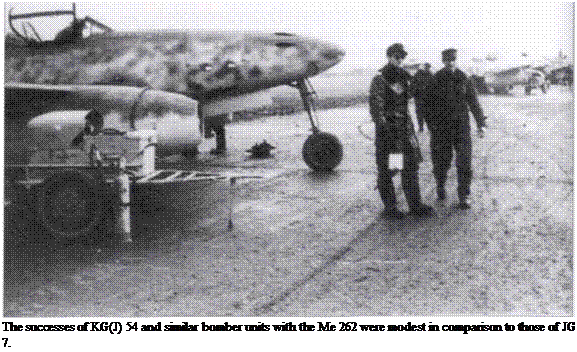
Conversion training and preparation for the coming battles in early 1945 continued at III./KG(J) 54 (Kommandeur Hauptmann Eduard Brogsitter). On 10 February 1945 the Gruppe could boast over thirty Me 262s as the result of new deliveries. Ground staff reported 90 per cent of these fit for operations. On 16 February 1945 Fifteenth Air Force operating from northern Italy attacked III. Gruppe s airfield at Neuburg/Danube. Several Me 262s were written off, and 16 suffered shrapnel damage. There were only light injuries amongst personnel. New machines were awaited, but by the beginning of March damage to the airfield had still not been repaired.
On 5 March 1945 I./KG(J) 54 concluded its Me 262 A-l training and was declared fully operational, the only Gruppe of the Geschwader to be so. On 18 March OKL ordered I. Gruppe and elements of the incompletely equipped
II. /KG(J) 54 to Zerbst in central Germany. On 19 March 125 Eighth Air Force bombers appeared over Neuburg but their aim this time was not so good, and
III. /KG(J) 54 survived until the attack by 366 B-24s on 21 March. Three days later another 271 Liberators arrived to finish the job. What was left of the infrastructure was transferred to Ganacker aerodrome between Straubing and Landau, the pilots being distributed between I./KG(J) 54, IIIVKG(J) 6 at Prague-Rusin and EKG(J) of IX Fliegerkorps at Pilsen (Plzen). Following another air raid on Neuburg the last airworthy Me 262s were flown to Ending near Munich.
I./KG(J) 54 flew its first operation from Zerbst over central Germany on 28 March 1945.Twenty-five Me 262s from III./JG 7 and KG(J) 54 attacked a 750- strong bomber stream despatched by Eighth Air Force. Ten bombers were shot down, most by JG 7 pilots. On 7 April 1945 I./KG(J) 54 pilots formed part of the fighter escort for the ram-fighters, taking off from airfields at Alt-Lonnewitz, Brandis and Zerbst.
On 9 April the Allies shot down or seriously damaged 17 of 21 Me 262s sent up by KG(J) 54. These losses could not be made good. The supply of new Me 262 jets had dried up, the last Me 262 A-l from the production line having been absorbed by KG(J) 54 on 20 February. Despite numerous losses in the first half of April, an average of 15 missions was being flown daily. During one of these on 10 April in bitter fighting with American aircraft, seven P-5 Is pursued Leutnant Jurgen Rossows Me 262 A-l of III./KG(J) 54: when he reduced speed for landing at Stendal they pounced. The aircraft was destroyed and Rossow seriously wounded. Other attacks on the jets ensued.
On 18 April III. Gruppe at Erding was attacked on the ground: on 1 May – without aircraft – the unit moved to Rinsting/Chiemsee. Four days later American tanks rolled in and took the greater part of the personnel prisoner. A few Me 262s of KG(J) 54 had reached Prague meanwhile and joined up with the Hogeback battle unit. On 8 May the last two airworthy Me 262s broke up while landing on pasture near Innsbruck. The unit, without aircraft, pulled back to Hallstadter See short of its intended destination, the airfield at Zeltweg.
Elements of III./EJG 2 flew fighter missions briefly from Lechfeld. From the autumn of 1944 the squadron served as a training unit for jet pilots under Major Werner Andres. On 17 January the unit had 14 Me 262 A-ls, 3 A-2s and 1 B-l plus 19 Bf 109s and Fw 190s, 20 Bf 110s and 4 He 219s. Between 5 February and 18 April the Gruppe received 27 Me 262 A-las. At the end of March the Kommandeur of III./EJG 2, Horst Geyer, was replaced by Oberstleutnant Heinz Bar, recently returned from the Eastern Front. Up to 19 April he obtained at least 18 victories with the Me 262, his last being on 28 April. Shortly before the war’s end it was proposed to incorporate III./EJG 2 into JG 7, while the ground staff were earmarked for I.(F)/100, a reconnaissance unit stationed within the Alpine Redoubt’.
Led by Generalmajor Adolf Galland, Jagdstaffel Galland was converted into JV 44, officially commissioned on 24 February. It received its first batch of 13 Me 262 A-Is and an Me 262 B-l with dual controls at the beginning of April. On 1 April 1945, JV 44 moved from Brandenburg to Munich-Riem, and a few days later had its first encounter over Bavaria. At that time, OKL was considering operating the unit from northern Italy, and had requested Generalfeldmarschall Kesselring to search out suitable airfields. The choice fell on Gallarate Malpensa and Lonate Possolo south-west of Lake Como, but the plan was dropped in the face of major problems of maintenance and transport from the replacement – engine shops.
On 18 April the first six Me 262 A-Is at Munich-Riem were at readiness for a defensive action over Bavaria: Oberst Steinhoff crashed on take-off and sustained severe burns. Next day JV 44 pilots used R4M rockets against enemy aircraft for the first time. After a lull of a few days, on 24 April the highly decorated fighter ace Oberst Giinther Liitzow failed to return from a mission near Donauworth. On 26 April the unit shot down five В-26 Marauders and a P-47; one Me 262 pilot had to bale out. Adolf Galland himself claimed a medium bomber, but while attacking a second B-26 was lightly wounded and finished the war recovering at Bad Wiessee/Tegernsee in a fighter-pilot convalescent home with one leg in plaster. Heinz Bar took over command and led JV 44 to the end. Meanwhile the tally of operational machines at JV 44 had risen to 40 Me 262s making it one of the strongest Me 262 units of the Luftwaffe in the final phase. IX. Fliegerkorps( J) accordingly ordered JV 44 to Prague. The instruction was then rescinded due to bad weather, and even the order to get the unit at least to Horsching/Linz was not executed.
On 1 May 1945 Major Wilhelm Herget’s Fi 156 landed unexpectedly at Schleissheim aerodrome north of Munich. It was in American hands, and he brought Generalmajor Galland s offer to surrender JV 44 to Brigadier General Menoher, Chief of Staff, US XV Corps. The American general accepted willingly. Herget returned with the unit adjutant – protected by American fighters – to Salzburg. It had been agreed that the 26 Me 262s would be divided into two groups and flown to Darmstadt and Giebelstadt respectively. As alternatives Major Herget nominated Leipheim and Schwabisch Hall, these being airfields held by the Americans. The plan to hand over the unit was delayed by bad weather and the limited fuel reserves at JV 44. On 2 May contact was severed abruptly after Major Herget’s Fi 156 was shot down in error and the Major hospitalised by the Americans, and thus the plan failed. On 3 May JV 44
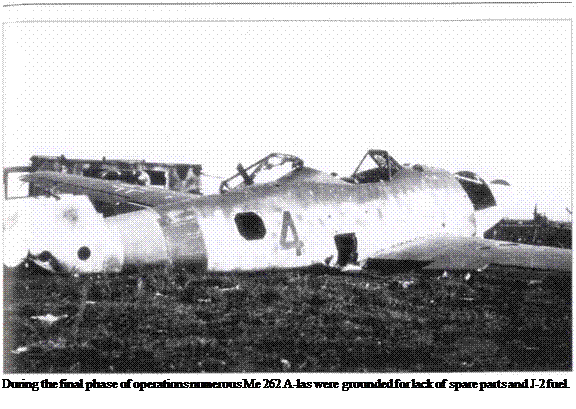
(Salzburg) was renamed IV./JG 7 and ordered to Innsbruck provided the airfield could take the aircraft. From there they were to fly to Klagenfurt and Horsching/ Linz. Nothing came of this, for on the morning of 4 May the SS blew up all 25 serviceable Me 262s of JV 44; one which had suffered light damage after a heavy landing at Salzburg was later captured by the Americans.










